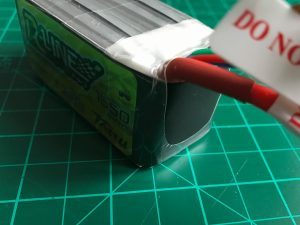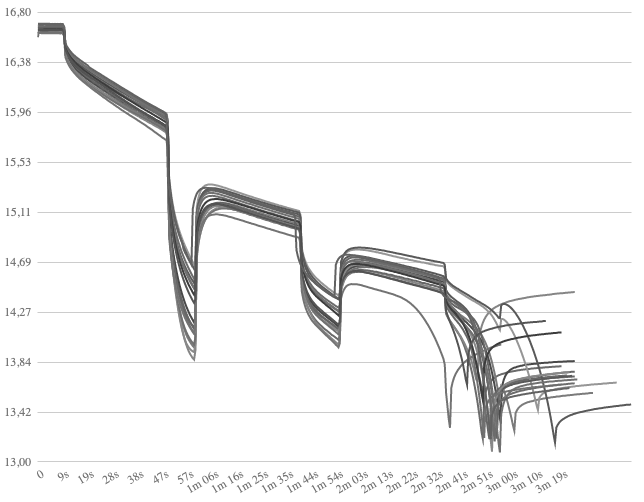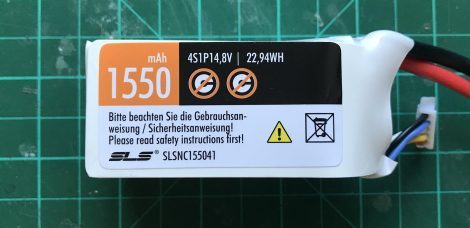I finally got my hands on the newest battery product from Gens Ace. This review is looking at the 1550 mAh version of the new Tattu R-Line 4S 95 C pack.
Appearance
The new Tattu R-Line 95C 1550 mAh packs* mostly stick to the overall design of Tattu batteries we have seen in the past. New is the yellow-ish reflecting design of the front. On the back you find a sticker that provides all the important information how to handle the battery. I really appreciate to see this stuff printed onto the pack. A lot better than giving out a small piece of paper as many other manufacturers tend to do. Gens Ace again uses transparent shrink wrapping so you can see the single cells inside your battery. The packs come in a high quality card box. The pack itself is packed in bubble wrap. A piece of foam makes sure nothing moves inside the box during transport. You also get one of theses plastics balancer wire protectors, you can assemble yourself if wanted.
Technical Design
The Tattu-R Line pack is a standard 4S1P config flight pack for high power use. The R-Line has been developed for racing competitions. Currently there only is the version 1.0 on the market. Gens Ace* seems to plan to release further version of the R-Line to addapt to pilots needs as best as possible. The newest version now is rated up to 95 C constant. We will see about that later.
Build Quality: Very good. Pack feels very well made on the outside. Connection terminal looks solid. A small layer of foam offers protection on the sides. The bright yellow-ish coloring looks good.
Plugs: The Tattu pack comes with standard XT60 connectors* equipped .
Cables: Gens Ace uses 12 AWG wires on this packs. The high flexible silicon layer is rated up to 200°C. Cable length is about 6.5 centimeters.
Balacing plugs: Standard XT-system. Balance wires are very short (4 cm) which is a benefit in terms of getting them out of the prop-range on the aircraft. Main power line and balancer wires are coming out of the top of the pack.
Technical Details
| Manufacturer | Gens Ace* | 
(Click to enlarge.) |
| Type | Tattu R-Line 95 C | |
| Cell chemistry | Lithium Polymere (LiPo) | |
| Cell type | Tattu R-Line | |
| Cell count | 4 | |
| Pack configuration | 4S1P | |
| Capacity | 1550 mAh | |
| Max. Charge Current | ? A | |
| Max. Discharge Current Continuous Burst |
147.25 A 294.5 A |
|
| Weight w/o plugs with plugs |
– ca. 195 grams |
|
| Measurements as listed measured |
35 x 36 x 72 mm 35 x 36 x 74 mm |
|
| Price | € 42.99 | |
| Dealer | Amazon* | |
| Note | This battery has been directly donated by the manufacturer / distributor for review purposes. |
Break-in documentation
The battery followed the standard break-in-process: The pack is charged at a rate of 1C until CV-phase ends with current of 1/10C. The break-in phase consists of four charging cycles at 1C and four corresponding discharges at 1 C / 4C / 10C and 20 C.
Anomalies: No anomalies during break-in.
Internal resistance measurements during break-in phase
| Cycle | Cell 1 | Cell 2 | Cell 3 | Cell 4 | Total |
| After first charge | 1.3 | 1.4 | 2.3 | 1.0 | 6.0 |
| After second charge | 1.2 | 1.2 | 1.5 | 1.3 | 5.2 |
| After third charge | 0.9 | 1.0 | 1.3 | 1.0 | 4.2 |
| After fourth charge | 1.2 | 1.3 | 1.1 | 1.3 | 4.9 |
Charging process
CV-Phase is very short on this cell type. Balancing in normal mode took 0:58 min. Cell drift during charge was unobtrusive. This is for 1C charge (1,5 A).
Load Testing
The main part of this battery test will consists of different load test settings showing the battery performance. Constant load testing is used to judge the advertised C-ratings as well as look at cell drift under high loads. We also check on internal resistance once more. Next up is the dynamic current test, which simulates a „real“ flight with changing (=dynamic) loads. For test methodology please check the dedicated methodology page!
Constant Load Testing
Constant load testing follows a certain load pattern of different constant currents. Base load is 10 C. Current pulses at 50 C, 35 C, 20 C and 30 C are maintained for time intervals between 10 and 20 seconds. For more details please refer to the test methodology page.
Capacity Usage
During this test the pack delivered 1171 mAh. This is 75,5 % of nominal capacity. A solid very good result.
Average cell voltages
The following table lists the average voltages per cell, of the total pack, as well as the averaged value per cell as fraction of total voltage during phase of active load.
| Cell 1 | Cell 2 | Cell 3 | Cell 4 | Total | Average per cell | |
| Avg. Voltages | 3.769 V | 3.768 V | 3.776 V | 3.775 V | 15.088 V | 3.772 V |
Just looking at average values the Tattu pack performs good. All cells stayed well above 3,7 V on average. An average value above 3,74 V / cell can be considered very good.
Focus Voltages
Exceptionally interesting when testing a battery under a constant load for a longer period of time: the lowest voltage per cell just before load impulse is disabled. On top, you should have look at voltage recovery rate, that is: how fast do cell voltages rise again once load impulse is cut.
| Phase | Cell 1 | Cell 2 | Cell 3 | Cell 4 | Total |
| End of 50 C | 3.662 V | 3.668 V | 3.690 V | 3.709 V | 14.729 V |
| End of 35 C | 3.602 V | 3.605 V | 3.618 V | 3.630 V | 14.445 V |
| End of 20 C | 3.401 V | 3.380 V | 3.423 V | 3,439 V | 13.643 V |
| End of 30 C | – | – | – | – | – |
Voltage sag is very low on the Tattu R-Line 1550 mAh pack. No cell went below 3,5 V/cell benchmark on first two load cycles. Good result!
Average voltage recovery per second
Those values are specific to the test setting and not valid for the pack in general! Still they allow an estimated guess about how fast voltages rise again after current spikes.
| Cell 1 | Cell 2 | Cell 3 | Cell 4 | Total | |
| Avg. Recovery | 0.0239 V / s | 0.0243 V / s | 0.0208 / s | 0.0182 V / s | 0.0873 V /s |
Voltage recovery is quick for the new R-Line 1500 mAh 80 C battery.
IR-Measurement
IR measurement is conducted using the four current pulses. Resistance for each cell is calculated in all four discharge phases. Shown values are averaged to cancel out different temperature points due to different discharge states during measurements.
| Cell | 1 | 2 | 3 | 4 | Total |
| Resistance [mΩ] | 1.97 | 1.90 | 1.69 | 1.8 | 7.35 |
Interpretation: The internal resistance of 1.84 mΩ average per cell indicates a „true“ C-rating of around 46 C (71.1 A). This is on the conservative side and represents a current draw that will make the pack last for a long time. Overall performance can be described as very high.
Cell drift under load
| Discharge Phase | 50 C | 35 C | 20 C | 30 C |
| Max Cell drift (V) | 0.018 V | 0.028 V | 0.094 V | – |
Cell drift is low on the new Tattu R-Line 95 C packs during main discharge phase. Cell 2 is a little weaker to the end of the discharge cycle and creates the drift difference at the very end of the test.
Key Temperature Facts
Temperature Development
Max. temp during discharge was around 53.2 °C on top of pack. Note that heating of stressed LiPo packs will continue for some more time even when load is cut.
Market Comparison
The following chart shows all reviewed LiPos in the same product segment for direct comparison of performance. Higher values under load are better.
Constant 25 C Discharge
Pretty much a standard benchmark in the LiPo industry.
Cut-Off /warning value for this battery should be chosen 3.5 V minimum. After this point voltage drops quick. The battery provided 1157 mAh (74,6 %) during the 25 C discharge.
Market Overview
Comparison of different reviewed 1500 mAh batteries under 25 C load.
Dynamic Load Testing
The dynamic load testing setting consists of two separate discharge scenarios that have been developed of two different real-life FPV flights. Pattern one represents a high speed low proximity flight around the open field with some hovering to the end. Average load is around 22 A. Second pattern is a free-style flight around trees in the park with some current spikes near 70 A. Average load on this flight is around 13 A due to longer floating periods.
Capacity Usage
During the test of pattern 1 the pack delivered 1177 mAh. This is 75.9 % of nominal capacity. Very good. In patter 2 testing 1158 mAh (74.7 %) could be used until first cell reached cut-off voltage.
Market Comparison
The following charts give an overview of all tested packs in the 1500 mAh class so far.
The last chart of this review sums up the usable capacity during all four load scenarios. Please note that this is only the capacity consumed by the electronic load! There are losses due to heating of the pack, which could be approximated (see testing methodology page). All four tests are cut when any cell goes below cut-off voltage of 3,3 V (or pack goes above 58 °C on any of the three probes). If you would push further and go down to 3,0 V/cell you will be able to squeeze out some mAh more, but at the cost of excessive heat generation and shortening of pack life-span. This value will most likely differ from what you get when flying on a quad as most people don’t monitor voltage on a per cell basis and therefore don’t even notice if voltage drops below 3,3 V/cell during punsh-outs (what’s not necessarily a good thing, though). For comparison, used capacity until 3,3 V/cell is reached is the base line in all battery reviews on Drone-Zone.de.
Conclusion
The new Tattu R-Line 4S 1550 mAh 95 C (V 1.0)* battery is a usual sized pack with a capacity to weight ratio of 7.94 mAh/g. Build quality of this battery is excellent. The pack is rectangular shaped and keeps it shape under every load situation. No puffing thanks to the metal sheets on both sides of the pack, which also help to spread heat across the outer cells. The design looks high quality. Voltage stability is good on the R-Line 95 C version 1.0. Cut-off should be chosen at 3,5 V / cell minimum. Usable battery capacity is very good. Note that this pack has a slightly higher capacity than standard 1500 mAh packs. Cell matching still can be improved as one cell (number 2) is a little weaker than the rest to the end of discharge cycle. The rating of 95C is a bit over the top, of course. I would rate this pack at amazing 46 C continuous. This allows you to pull around 71.1 A without having to worry about the packs health too much. More than enough head room for most of the applications out there and one of the best result in the 1500 mAh class so far. As you can see in the dynamic loads higher current spikes are handled well. For around 43 € this pack is certainly not cheap at all. In the end you get what you pay for. Due to its slightly higher capacity it goes head on head with the great Dinogy Ultra Graphene 2.0 1500 mAh 80 C product, even though the Tattu pack does not have graphene-enabled chemistry*. In the end this battery is a premium product, which almost catches up with the graphene competition. If you are willing to take the price tag the Tattu R-Line most likely will not disappoint you.
Other packs of this line up tested:















